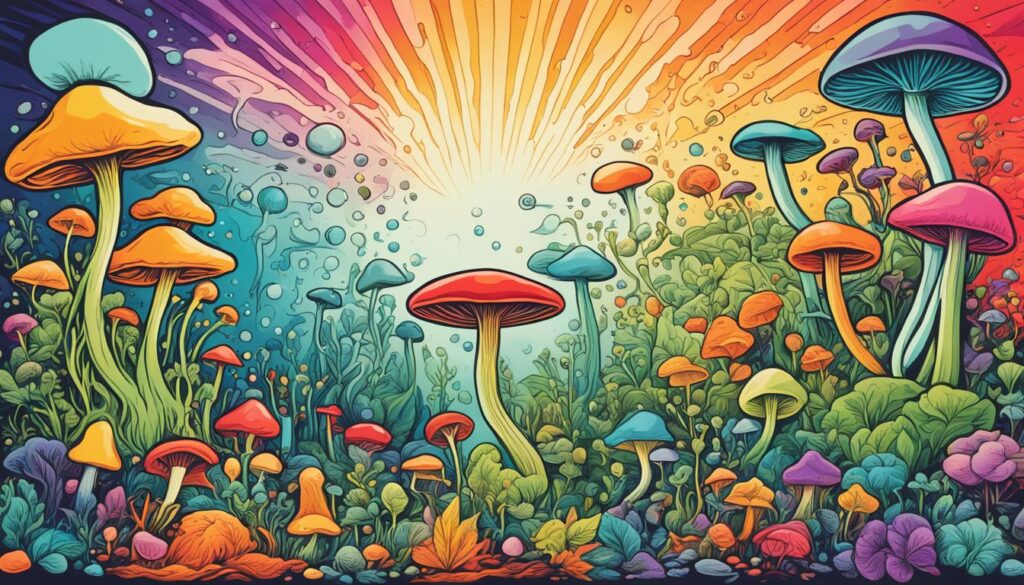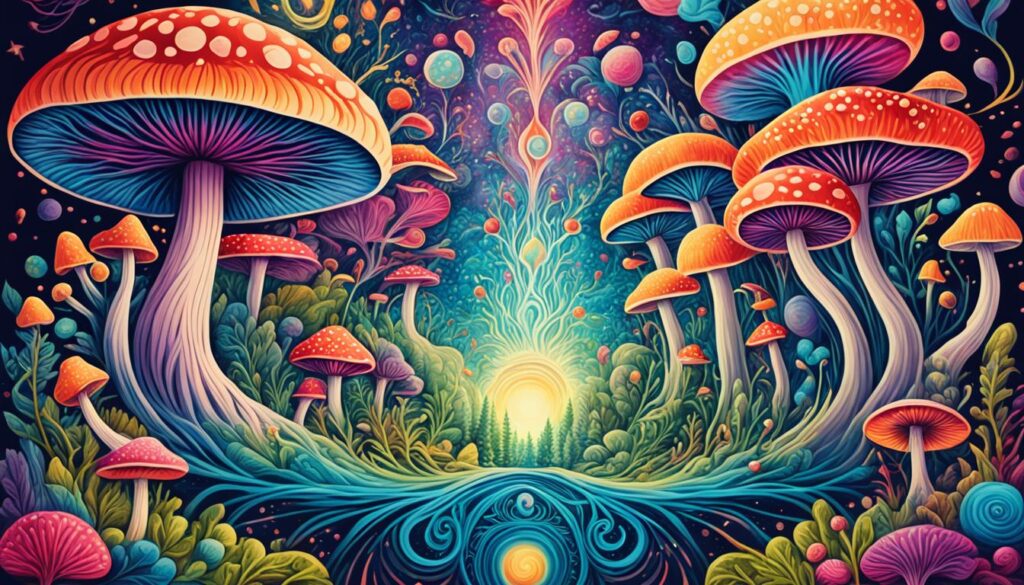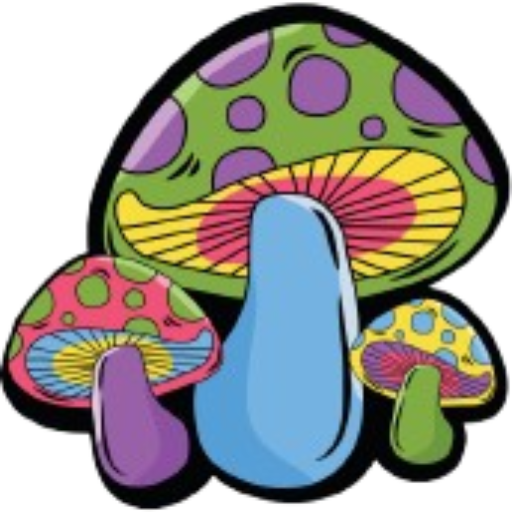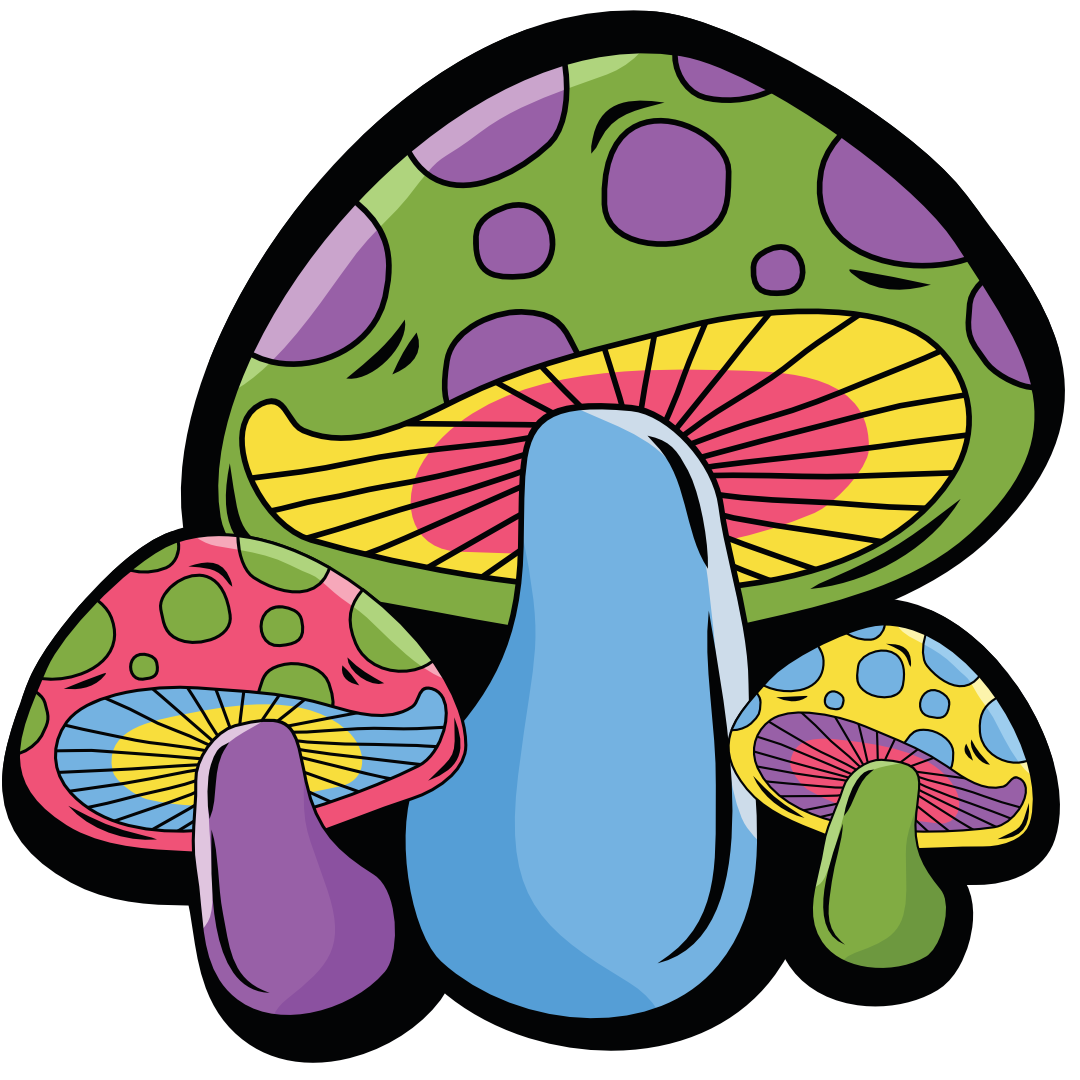Psilocybin, found in “magic” mushrooms, has shown promise for treating mental health issues like depression and anxiety1. It’s important to know the right dosage, especially for those new to it. This guide will cover different dosages, including microdosing and therapeutic use. We’ll look at the benefits and risks to help you make safe choices.
Introduction to Psilocybin
Psilocybin is the main active substance in some mushrooms, known as “magic mushrooms.”2 For centuries, indigenous cultures have used these mushrooms for spiritual and healing purposes2.
What are Magic Mushrooms?
Magic mushrooms are a type of fungi that naturally make psilocybin2. This substance changes into psilocin in the body2. Psilocin levels peak about 20-30 minutes after eating them2. It stays active for about 3 hours2.
Traditional and Indigenous Use
In Mexico and Central/South America, groups like the Nahuatls and Mayans have used these mushrooms for health and understanding sickness2. Recently, researchers in the U.S. have started studying psilocybin for mental health issues3.
Psilocin connects with many brain receptors, including those for serotonin and dopamine2. It also affects other receptors in the body2.
“Psilocybin neuromodulatory effects are correlated with 5-HT2AR occupancy, and it promotes enhanced neuroplasticity, seen as increased resting-state functional connectivity across brain networks, particularly involving the prefrontal cortex.”2
Psilocybin can make brain cells grow and change in healthy ways2.
Psilocybin Dosage
Psilocybin, found in “magic mushrooms,” comes in different dosages, from tiny amounts to full therapeutic levels. Knowing the right dosage is key for safe and effective use. This is true whether you’re exploring on your own or looking for health benefits.
Microdosing Psilocybin
Microdosing means taking a tiny bit, usually 10-20% of what’s needed for a full trip4. The aim is to get some cognitive and emotional boosts without the full-on trip. A microdose is about 0.1 – 0.2 grams4.
Therapeutic Psilocybin Dosage
In medical settings, psilocybin is given in stronger doses to help with depression and anxiety5. These doses can lead to deep psychedelic experiences that might improve mental health for a long time5. The dosage depends on the mushroom’s strength, type, and what part you use, usually between 1.0 – 2.5 grams4.
Research shows that giving 20 to 30 mg of psilocybin per 70 kg of body weight is safe for many people at once6. This shows psilocybin can be safely given to people, which is important for treating serious mental health issues like depression and PTSD6.
Remember, the right dosage and how to take psilocybin should always be checked with a healthcare professional. They’ll consider your unique situation and what you’re trying to achieve.

“The analyzed data included a wide range of body weights from 49 to 113 kg, showing no evidence that body weight influenced the subjective effects of psilocybin.”5
Short-Term Effects of Psilocybin
Psilocybin, found in over 100 mushroom species, changes the mind and body quickly7. These effects start within 15-45 minutes and can last hours.
Users may feel more emotions, see things differently, and time can seem to slow down or speed up7. The effects depend on the dose, with higher doses causing deeper and sometimes scary experiences7.
Psilocybin can make your heart race, raise blood pressure, and cause nausea7. You might feel weak, have a change in body temperature, and struggle with coordination and judgment7.
Most psilocybin use is safe in a controlled setting, but some people have bad trips with anxiety, fear, and paranoia7. These bad experiences can be scary and might lead to ongoing mental health issues7.
Research shows psilocybin can have both good and bad effects on mental health8. A study found stress and anxiety levels went down after using psilocybin, but then went back to normal a month later8.
The effects of psilocybin can be different for everyone, depending on the dose, your body, and the setting7. It’s important to be careful and use it with guidance from experts to avoid risks and get the most benefit7.

| Psilocybin Short-Term Effects | Mental Effects | Physical Effects |
|---|---|---|
| Heightened emotions | ✓ | |
| Sensory distortions | ✓ | |
| Altered time perception | ✓ | |
| Hallucinations | ✓ | |
| Increased heart rate | ✓ | |
| Increased blood pressure | ✓ | |
| Nausea | ✓ | |
| Muscle weakness | ✓ | |
| Changes in body temperature | ✓ |
Psilocybin’s effects can change a lot from person to person, based on the dose and setting7. Some have great experiences, while others may feel anxious, panicked, or even psychotic7.
“Psilocybin can produce profoundly unpleasant experiences at high doses, and there are risks associated with mushrooms, including impaired judgment, anxiety or panic attacks, bad trips, poisoning, and death from consuming the wrong type of mushroom.”7
Using psilocybin responsibly is key7. Knowing the effects and risks helps people make smart choices and get advice from experts for a safe and meaningful experience7.
Potential Benefits of Psilocybin
Research is showing that psilocybin, a compound in some mushrooms, could help with mental health issues9. It seems to help people with hard-to-treat depression, obsessive-compulsive disorder, and cancer patients’ fear and anxiety9.
Psilocybin for Depression
A study at Johns Hopkins Medicine found that psilocybin with talk therapy helped with depression9. Some people felt better for up to a year after just two treatments9. It also helps increase brain flexibility, which is good for those with depression9.
Psilocybin for Anxiety Disorders
Psilocybin has shown promise in helping people quit smoking and treat anorexia nervosa, leading to more research in the U.S9. It can also make people more open-minded, creative, and caring9.
More studies are needed, but early results suggest psilocybin-assisted therapy could be a big step forward for mental health9.

Research over the last 20 years shows psilocybin could be a game-changer for mental health9.
“Psilocybin therapy has been found beneficial in relieving symptoms of treatment-resistant depression, obsessive-compulsive disorder, and easing fear and anxiety in individuals with terminal cancer.”
But, using psilocybin outside of a controlled setting is risky and illegal9.
Potential Risks of Psilocybin
Psilocybin, found in “magic mushrooms,” has shown promise for therapy10. But, it’s not risk-free10. Physical side effects can include nausea, vomiting, headaches, and more10. You might also feel anxiety, fear, or isolated thoughts10. These effects depend on the dose and setting.
Physical Side Effects
Psilocybin can cause physical effects, some of which are concerning11. You might feel numb, have a fast heart rate, or weak muscles11. Rarely, it can lead to serious issues like muscle damage or kidney failure10. People with heart problems could be at higher risk due to its effects on heart rate and blood pressure12.
Psychological Side Effects
Psilocybin’s effects on the mind can be deep11. You might feel more emotions, become paranoid, or lose your sense of reality11. In some cases, it can cause flashbacks that last for a long time11. Regular use can make it hard to adjust back to everyday life11. If you’re prone to mental health issues, psilocybin could be more dangerous12.
Psilocybin has shown promise in studies12. But, there are no approved products with psilocybin in Canada or other places12. It’s key to screen and assess risks to see who might benefit or be at risk from it10.
“The use of psilocybin with other substances like cannabis or alcohol may elevate the risks of adverse effects.”12
Psilocybin Sources and Safety
Psilocybin, found in psychedelic mushrooms, comes from various species, with Psilocybe cubensis being the top source13. But, the amount of psilocybin and its breakdown product psilocin can change a lot, making it hard to know the right dose13. In studies, scientists use made psilocybin, but most people use the real mushroom kind14.
There are ways to check the psilocybin in mushrooms and look for harmful stuff, which is key for safety13. Now, more people in the U.S., about 8 million adults, have tried psilocybin mushrooms in the last year13. It’s more popular than other drugs like MDMA and LSD13.
Mushroom Species and Potency
The amount of psilocybin in magic mushrooms can be quite different, from 0.1% to 2% by weight15. For example, 3.5 grams might have 35 mg of psilocybin, which is a strong dose15. Some people take a smaller dose, around 100 mg to 250 mg, for microdosing15.
Interest in microdosing psilocybin has grown a lot since 2015, with many trying it for fun or mental health13. Oregon and Colorado are leading in this trend, as they’ve made it easier to use these mushrooms13. But, we need more studies to know if it’s safe and works well13.
More people are finding psilocybin, leading to more drug busts13. A survey found people use it for fun, mental health, and personal growth13.
“Psilocybin was safely given in doses of 10mg or 25mg to up to six people at once in the study.”14
A study tested psilocybin on 89 healthy people, giving some 10mg or 25mg, and others a fake pill14. They watched these people for a few hours and checked in with them for 12 weeks. No one stopped because of bad reactions to the drug14.
The next step in this study is to see if psilocybin helps with depression and PTSD14. They plan to start this part in 202214.
Legality and Access to Psilocybin
In Canada, psilocybin is illegal to make, sell, and have. But, there are legal ways to get it for health reasons16. This change shows how the rules on psilocybin are changing17.
Clinical Trials and Legal Access
Canada has approved 36 studies on psilocybin18. These studies look at how it can help with depression and PTSD18. There’s also a program that lets doctors get psilocybin for their patients17.
So far, 176 Canadians can use psilocybin through this program18. Doctors need a license to get it, and they must report any bad reactions quickly17.
A Canadian company, Filament Health, can make three types of psilocybin capsules18. Health Canada also made a rule to allow more use of psilocybin and MDMA17.
People want more research on psilocybin for mental health, especially for veterans with PTSD18. Health Canada wants more money for studies on using psilocybin therapy for these veterans18.
“Psilocybin and MDMA are the most frequently used psychedelic drugs in psychedelic-assisted psychotherapy.”17
Screening and Risk Assessment
When looking into psilocybin-assisted therapy, it’s key to screen and assess risks to find who will benefit or be at risk19. We use established methods to keep out those at high risk, but we need more tools for psilocybin19. Researchers aim to create better ways to predict how people will react to psilocybin, ensuring it’s given safely19.
Things like a person’s traits, health history, and where they take psilocybin affect the risks and benefits19. It’s vital to talk to health experts who know about psilocybin therapy to see if it’s right for you and plan your treatment19.
Health Canada sees the growing interest in using psychedelics for therapy, knowing there are risks for those in clinical trials19. In Canada, MDMA and psilocybin are often used in trials, making people feel happy, outgoing, and more connected19. Psilocybin can change moods, make you see things differently, and change how you see time19.
For safe use of psilocybin, therapists should be trained and licensed, with at least two there during the session19. A doctor must oversee the trial and be ready to help, and the place should be calm to lessen risks19. After therapy, checking in with mental health professionals is important, and any big problems must be reported to Health Canada19.
| Key Considerations for Psilocybin Risk Assessment |
|---|
|
Before starting psilocybin therapy, you must understand the risks, both physical and mental19. Making sure products are made safely is crucial, and Health Canada checks to make sure trials and products follow the rules19.
Psilocybin has a long history, used for thousands of years in many cultures20. Albert Hofman isolated it in 1958, the same year he made LSD20. Studies show it can help with addiction, depression, and mood at the end of life, giving hope to many20.
A big study looked at 436 people, finding psilocybin really helped with depression, especially for those with secondary depression21. Being older or having tried psychedelics before seemed to help more with symptoms21.
“Psilocybin has shown promise in the treatment of addiction, particularly in small, open-label trials focusing on nicotine and alcohol, with a low toxicity and low risk of overuse.”20
As psilocybin therapy grows, making sure we screen and assess risks well is key. Working with health experts and following safety steps helps people safely try this new therapy.
Conclusion
This guide has shown that psilocybin, found in “magic” mushrooms, could help with mental health issues like depression, anxiety, and addiction5. But, using psilocybin safely and effectively means knowing the right dosage, its benefits, and risks.
We looked at the various psilocybin dosages, from microdosing to therapeutic use. We also talked about the immediate effects, benefits, and risks of taking psilocybin522. The article also covered the legality and accessibility of psilocybin. It stressed the need for advice from healthcare pros in psilocybin-assisted therapy.
As studies show more about psilocybin’s therapeutic potential, it’s key to use it with caution, responsibility, and care for your health and safety52223. Knowing about psilocybin dosage, safety, and therapeutic use helps people make smart choices. This way, they can try this amazing compound responsibly.
FAQ
What is the difference between microdosing and therapeutic dosing of psilocybin?
What are the potential short-term effects of psilocybin use?
What are the potential therapeutic benefits of psilocybin?
What are the potential risks associated with psilocybin use?
How can individuals access psilocybin legally?
How important is proper screening and risk assessment for psilocybin-assisted therapy?
Source Links
- Psilocybin – an overview | ScienceDirect Topics
- Psilocybin in neuropsychiatry: a review of its pharmacology, safety, and efficacy | CNS Spectrums | Cambridge Core
- mushrooms_onesheet
- Optimal dosing for psilocybin pharmacotherapy: Considering weight-adjusted and fixed dosing approaches
- Psilocybin, in 10mg or 25mg doses, has no detrimental effects in healthy people
- Effects of Psilocybin Mushrooms | Hallucinogenic Shrooms
- Emotions and brain function are altered up to one month after a single high dose of psilocybin – Scientific Reports
- “Magic Mushrooms,” Psilocybin and Mental Health
- PSILOCYBIN: Overview, Uses, Side Effects, Precautions, Interactions, Dosing and Reviews
- Psilocybin and magic mushrooms
- Psilocybin and psilocin (Magic mushrooms)
- Microdosing and tripping on mushrooms is on the rise in U.S.
- Study Identifies Safe Dosage Regimen for Psilocybin
- Magic Mushroom Dosing Guide: Finding Your Ideal Dose
- Legal status of psilocybin mushrooms
- Notice to stakeholders: Requests to the Special Access Program (SAP) involving psychedelic-assisted psychotherapy
- Canadians can ask for legally produced medicinal psilocybin. Getting it isn’t always easy
- Notice to stakeholders: Health Canada’s expectations regarding risk-management measures for clinical trials involving psychedelic-assisted psychotherapy
- Analysis of Psilocybin-Assisted Therapy in Medicine: A Narrative Review
- Efficacy of psilocybin for treating symptoms of depression: systematic review and meta-analysis
- Johns Hopkins study finds Psilocybin dosage ‘sweet spot’ for positive and lasting effects
- Psilocybin – an overview | ScienceDirect Topics

